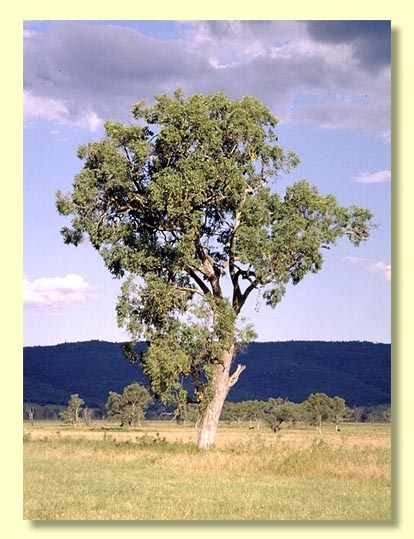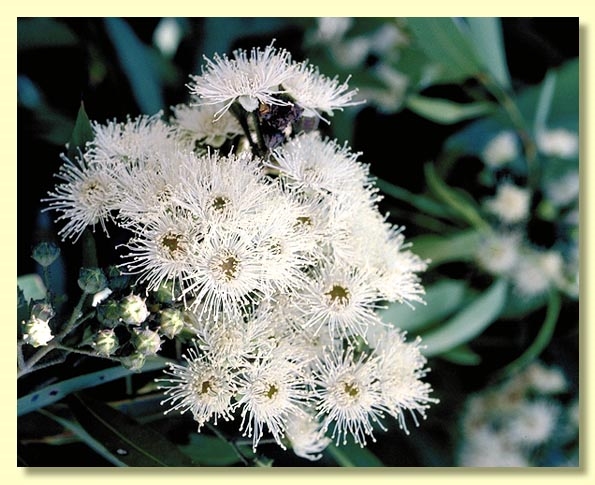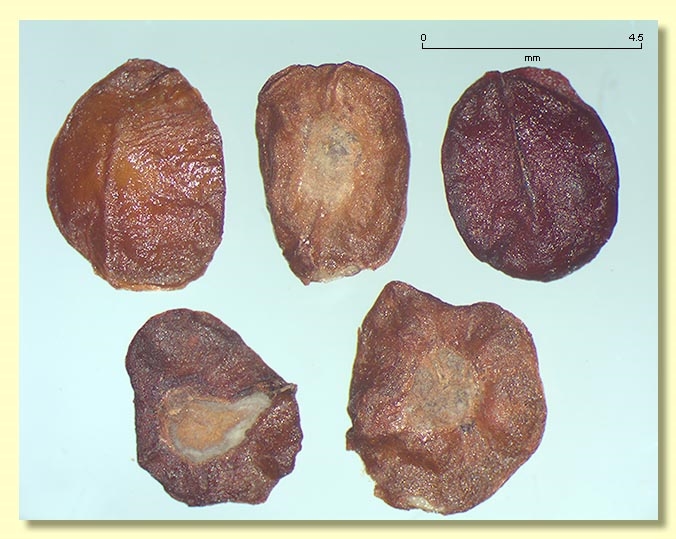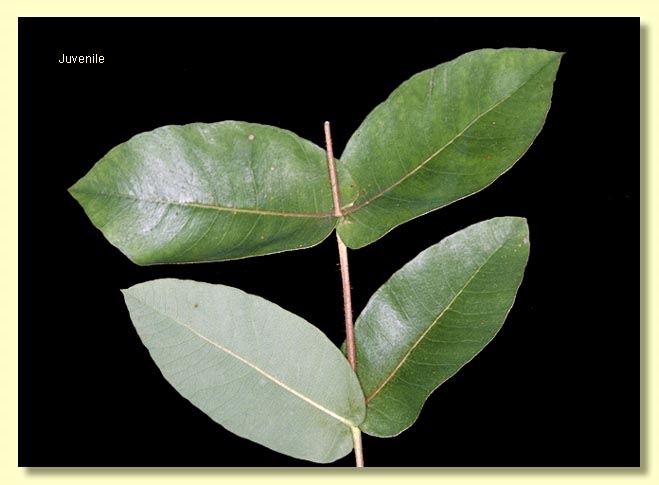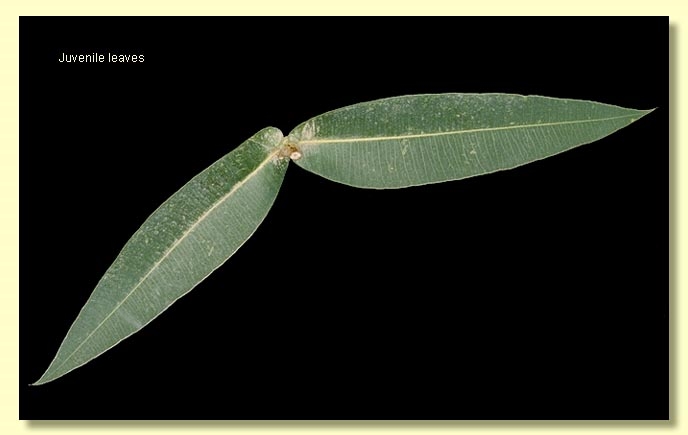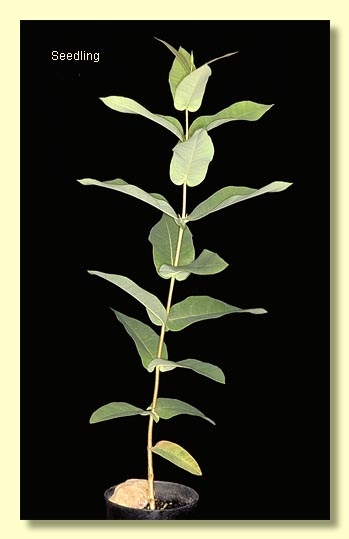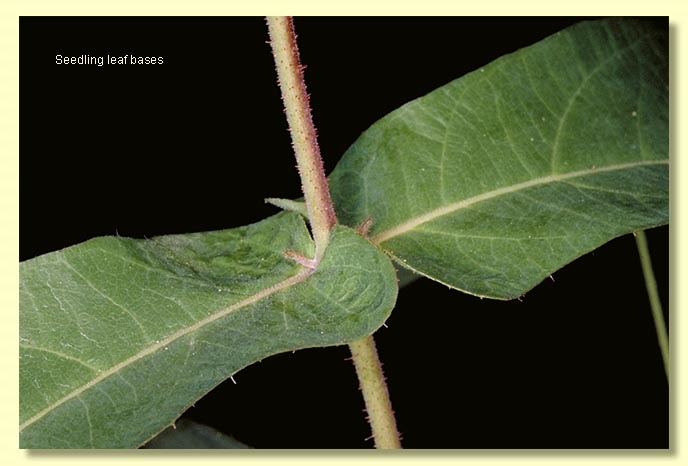Euclid - Online edition
Angophora floribunda
Angophora
Metrosideros floribunda Sm., Trans. Linn. Soc. London 3: 267 (1797); Acmena floribunda (Sm.) DC., Prodr. 3: 262 (1828); Eucalyptus florida Brooker, Austral. Sys. Bot. 13: 136 (2000). T: Port Jackson, NSW, 1795, J.White; holo: LINN.
Angophora intermedia DC., Prodr. 3: 222 (1828). T: New Holland, 1816, A.B.Lambert s.n.; holo: G-DC.
Angophora ochropylla R.T.Baker, Proc. Soc. Linn. New South Wales 38: 601 (1914). T: Myall Creek, near Bingarra, NSW, Apr. 1911, C.F.Laseron NSW 167269; lecto: NSW.
Medium-sized to large tree to 30 m tall. Forming a lignotuber.
Bark rough to the small branches, shortly fibrous and generally furrowed, grey to brown. Glands (or ducts) sometimes present in the pith but only seen just below the nodes on young branchlets.
Juvenile growth (coppice or field seedlings to 50 cm): stem rounded in cross-section, pubescent or glabrous; juvenile leaves opposite, petiolate or sessile, cordate to oblong to narrowly lanceolate to ovate, 4.5–12 cm long, 2–5 cm wide, base amplexicaul to rounded, margin entire or rarely finely toothed, apex acute, green, pubescent or glabrous.
Adult leaves opposite, petioles 0.6–1.5 cm long; blade narrowly lanceolate to ovate, occasionally falcate, 5.5–15 cm long, 1–5 cm wide, flat to undulate, base tapering to petiole or rounded, margin entire, apex acute, discolorous, glossy green to dull grey-green, penniveined, densely to very densely reticulate, intramarginal vein present, oil glands island.
Inflorescence terminal compound, peduncles 1–3.3 cm long, buds 3 or 7 per umbel, pedicellate (pedicels 0.3–0.9 cm long). Mature buds globular (0.3–0.5 cm long, 0.3–0.5 cm wide), hypanthium pubescent or glabrous, longitudinally ribbed, petals white with a green keel, stamens inflexed, anthers oblong, versatile, dehiscing by longitudinal slits (non-confluent), style long, stigma blunt, mop-like, locules 3 or 4, the placentae each with 5 vertical ovule rows. Flowers white or creamy white.
Fruit pedicellate (pedicels 0.3–1.4 cm long), barrel-shaped to cup-shaped, (0.6)0.7–1.2 cm long, 0.7–1.1 cm wide, longitudinally ribbed, disc descending, valves 3 or 4, enclosed.
Seeds reddish brown to brown, 5.5–7 mm long, flattened-ellipsoidal, dorsal surface smooth, hilum ventral.
Cultivated seedlings (measured at ca node 10): cotyledons reniform to orbicular; stems rounded in cross-section, scabrid with bristle-glands and hairs; leaves opposite, sessile, lanceolate to oblong, 4.5–9(10)cm long, (1.5)2–4(5) cm wide, amplexicaul, margin entire or irregular, apex pointed or rounded, discolorous, green, slightly scabrid or glabrous.
Flowering has been recorded in January, February and December.
It belongs to the group of Angophora species that have rough bark and develop true adult leaves in the mature crown. The other members are A. bakeri, A. inopina, A. woodsiana and A. melanoxylon.
A. floribunda is a medium-sized to tall tree differing from A. bakeri, a smaller tree with shorter petioles and narrower adult leaves (usually less than 1.5 cm wide). A. inopina, a small stunted tree from the Wyee area just north of Sydney, is very close to A. floribunda and may be no more than a stunted coastal form of that species. A. woodsiana differs from A. floribunda in having longer pedicels, usually longer than 1 cm. A. melanoxylon, from inland northern New South Wales and southern Queensland normally has a mixture of petiolate adult leaves and sessile juvenile leaves in the mature crown. Both the adult and juvenile leaves of A. melanoxylon are narrower than those in A. floribunda .
A. floribunda is a species that varies, particularly in the width of the adult leaf. Populations in the western part of its range in New South Wales, e.g. in the Narrabri area, tend to be much narrower than those of the coastal ranges and in some parts may grade towards A. bakeri.
MORE ABOUT ANGOPHORA

